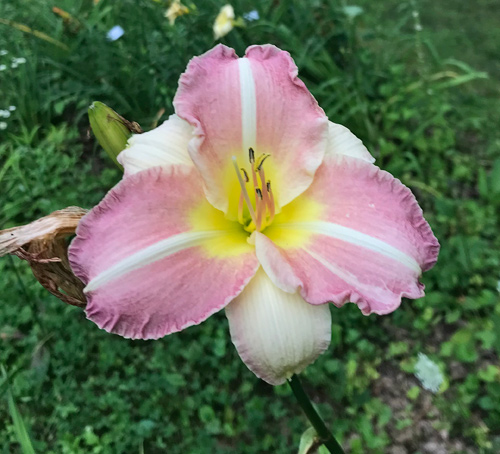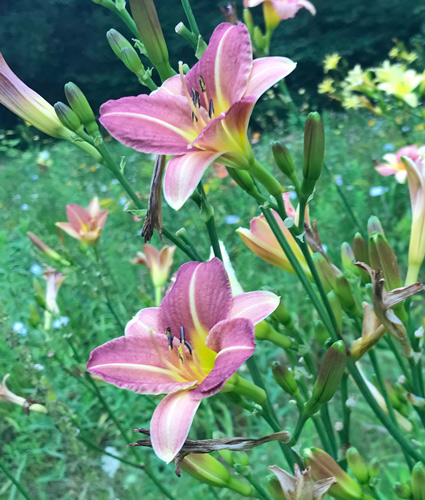|

Hemerocallis fulva
Commonly known as the Orange Roadside Lily, the Ditch Lily or even Tigerlily is probably the best known daylily in the U.S. if not the world. With an aggressive spreading habit and tall showy orange blooms, it never fails to make an impression.

Linda, a Hem fulva hybrid developed by Dr Stout in the 1930's has many of the characteristics of H. fulva but not the invasive spreading habit.
|

Hemerocallis fulva:
The spreading habit is clearly visiible as are the tall scapes
|

Hemerocallis fulva 'Kwanso'is a spreading variant with double blossoms. Below is the rarer variegated version of "Kwanso'. The variegated leaves can revert
and so the all green shoots must be removed in order to retain a variegated stand
|
| Hemerocallis hakuensis |
|

Hemerocallis hakuensis begins blooming in early July here in Vermont. Hem hakuensis produces numerous orange-yellow trumpet-shaped blooms. Good growth and high seed set are characteristic of this species.
|

Hemerocallis hakuensis
can produce up to 35 buds per scape and blooms well into August.
|

Hem. hakuensis and Hem citrina vespertina blooming side by side, July 29 2008.H. hakuensis is in full bloom whereas H. citr vespertina is just beginning.
|
| Hemerocallis altissima |
|

Hem. altissima
produces lemon yellow blooms on scapes up to 5-6 feet tall.
|

Hem. altissima produces masses of upward facing blooms in mid July.
|

The foliage of Hem. altissima like most of the H. citrina complex is tall vigorous and seems to be very disease resistant.
|
| Hemerocallis citrina |
|

Hemerocallis citrina
Also called the Citron lily has a lemony scent and is nocturnal. Flowers open late in the day and remain open through midday the next day. Trumpet shape,lemon yellow spider-like blooms are typical of H. citrina. Here H. ctrina blooms along with Geranium 'Johnson's Blue", July 8, 2007.
|

Hem. citrina exhibits much variation. Above is a H. citrina type we discovered.

This H. citrina was photographed at Tranquil Lake Nursery in Mass.
|

Strong growth and tall vigorous foliage is typical of all H. citrina types.
|
| Hemerocallis citrina vespertina |
|

Hemerocallis citrina vespertina
is an a variant of H. citrina and depending on the taxonomy is a subspecies or a seperate species. Extremely tall with wide branching it makes a wonderful show and has huge breeding potential
|

Hem. citr. vesp. blooms from mid July into the end of August.
|

Hemerocallis citr. vesp. typically has 4" trumpet shaped blooms but through hybridization a large variation of size and shape can be achieved.
|
| |

 Olallie Hazey Daisy: Early pink bicolor. Amazing bud count
Olallie Hazey Daisy: Early pink bicolor. Amazing bud count 


























